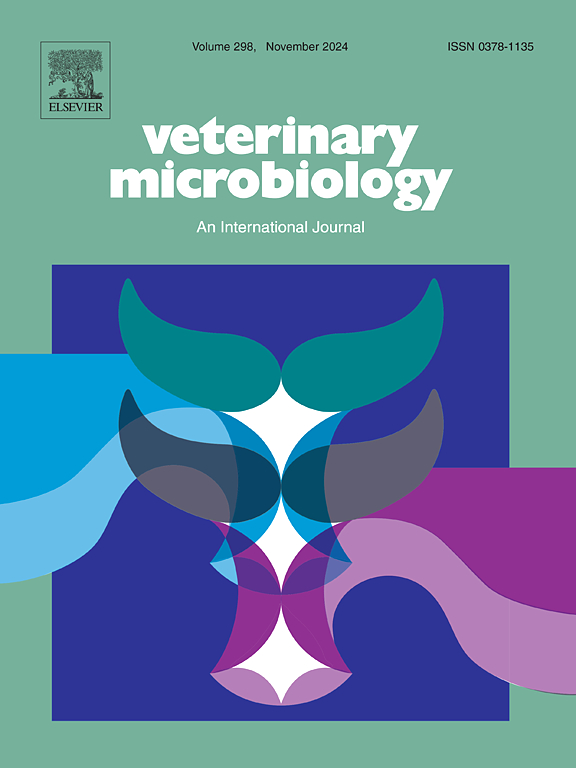马立克氏病病毒编码的MicroRNA-M6-5p通过靶向病毒主要衣壳蛋白编码基因UL19抑制病毒复制
IF 2.4
2区 农林科学
Q3 MICROBIOLOGY
引用次数: 0
摘要
马立克氏病病毒(MDV)是一种引起鸡淋巴细胞增生性疾病的细胞相关的甲疱疹病毒。MicroRNAs (miRNAs)是一类20 - 25个核苷酸的长单链非编码rna,在转录后调控中起重要作用。mdv编码的mirna对病毒复制和肿瘤发生至关重要;然而,潜在的机制仍不清楚。我们之前已经发现,mdv编码的miR-M6-5p在体外抑制病毒复制。在这项研究中,我们确定了主要的病毒衣壳蛋白编码基因UL19作为miR-M6-5p的直接功能靶点。过表达miR-M6-5p显著降低UL19的表达,并伴有病毒颗粒数量的减少。相反,敲除miR-M6-5p可增强UL19的表达,并伴有病毒颗粒数量的增加。与此一致的是,UL19缺失的MDV突变体不能在感染细胞中复制和组装衣壳结构。因此,miR-M6-5p通过靶向UL19基因损害衣壳组装来抑制MDV复制。这些发现揭示了病毒编码的mirna如何通过靶向结构形态成分来调节病毒复制,并拓宽了我们对mdv编码的mirna在病毒复制中的作用的理解。本文章由计算机程序翻译,如有差异,请以英文原文为准。
Marek’s disease virus-encoded MicroRNA-M6-5p suppresses viral replication by targeting viral major capsid protein-coding gene UL19
Marek’s disease virus (MDV) is a cell-associated alphaherpesvirus that causes lymphoproliferative diseases in chickens. MicroRNAs (miRNAs) are a class of 20–25-nucleotide long single-stranded non-coding RNAs that play an important role in post-transcriptional regulation. MDV-encoded miRNAs are critical for viral replication and tumorigenesis; however, the underlying mechanisms remain unclear. We have previously found that MDV-encoded miR-M6-5p inhibits viral replication in vitro. In this study, we identified the major viral capsid protein-coding gene UL19 as a direct functional target of miR-M6-5p. The overexpression of miR-M6-5p significantly reduced UL19 expression, accompanied by a decrease in the number of viral particles. In contrast, the knockout of miR-M6-5p enhanced UL19 expression, accompanied by an increase in the number of viral particles. Consistently, MDV mutants with UL19 deletions could not replicate and assemble capsid structures in infected cells. Thus, miR-M6-5p inhibits MDV replication by impairing capsid assembly by targeting the UL19 gene. These findings reveal how virus-encoded miRNAs regulate viral replication by targeting structural morphogenic components and broaden our understanding of the role of MDV-encoded miRNAs in viral replication.
求助全文
通过发布文献求助,成功后即可免费获取论文全文。
去求助
来源期刊

Veterinary microbiology
农林科学-兽医学
CiteScore
5.90
自引率
6.10%
发文量
221
审稿时长
52 days
期刊介绍:
Veterinary Microbiology is concerned with microbial (bacterial, fungal, viral) diseases of domesticated vertebrate animals (livestock, companion animals, fur-bearing animals, game, poultry, fish) that supply food, other useful products or companionship. In addition, Microbial diseases of wild animals living in captivity, or as members of the feral fauna will also be considered if the infections are of interest because of their interrelation with humans (zoonoses) and/or domestic animals. Studies of antimicrobial resistance are also included, provided that the results represent a substantial advance in knowledge. Authors are strongly encouraged to read - prior to submission - the Editorials (''Scope or cope'' and ''Scope or cope II'') published previously in the journal. The Editors reserve the right to suggest submission to another journal for those papers which they feel would be more appropriate for consideration by that journal.
Original research papers of high quality and novelty on aspects of control, host response, molecular biology, pathogenesis, prevention, and treatment of microbial diseases of animals are published. Papers dealing primarily with immunology, epidemiology, molecular biology and antiviral or microbial agents will only be considered if they demonstrate a clear impact on a disease. Papers focusing solely on diagnostic techniques (such as another PCR protocol or ELISA) will not be published - focus should be on a microorganism and not on a particular technique. Papers only reporting microbial sequences, transcriptomics data, or proteomics data will not be considered unless the results represent a substantial advance in knowledge.
Drug trial papers will be considered if they have general application or significance. Papers on the identification of microorganisms will also be considered, but detailed taxonomic studies do not fall within the scope of the journal. Case reports will not be published, unless they have general application or contain novel aspects. Papers of geographically limited interest, which repeat what had been established elsewhere will not be considered. The readership of the journal is global.
 求助内容:
求助内容: 应助结果提醒方式:
应助结果提醒方式:


